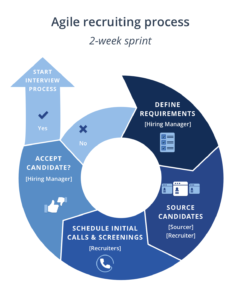Vatsal Shah
Certified ScrumMaster® | Agile Technical Project Manager
Agile Recruitment Strategies: Adapting to Dynamic Talent Needs
Introduction:
Recruitment has evolved into a dynamic and ever-changing landscape. In today’s fast-paced world, traditional hiring methods often fall short in meeting the needs of organizations seeking top talent. Agile recruitment strategies are the answer, offering a fresh perspective on attracting and retaining the right people. In this article, we’ll explore the principles and practices of Agile recruitment, helping you adapt to the dynamic talent requirements of the modern workforce.
The Shifting Talent Landscape:
The emergence of remote work, the gig economy, and changing employee expectations have transformed the talent landscape. To remain competitive, organizations must adopt recruitment strategies that are as dynamic as the workforce itself.
What is Agile Recruitment?
Agile recruitment applies the principles of agile software development to hiring. It emphasizes collaboration, iterating rapidly, and responding to change. Rather than following a rigid, linear recruiting process, agile recruiting:
- Focuses on continuous improvement and learning
- Uses cross-functional, collaborative hiring teams
- Works in short cycles to take action, get feedback, and improve
- Values responding to change and uncertainty over following a plan
This nimble approach allows recruiters to meet dynamic hiring needs in an evolving talent landscape.
Agile Recruitment Principles:
- Continuous Improvement:Agile recruitment embraces a mindset of continuous improvement, seeking feedback and making data-driven adjustments to optimize the process.
- Collaboration:Cross-functional collaboration is central to Agile recruitment. HR teams, hiring managers, and even current employees work together to identify and attract top talent.
- Adaptability:Agile recruitment is flexible and adaptive. It can quickly pivot to address changes in the job market or evolving business needs.
- Customer-Centricity:The candidate is at the heart of Agile recruitment. A positive candidate experience is prioritized to attract and retain top talent.
Key Agile Recruitment Practices:
- Sourcing and Outreach:Agile recruitment leverages various sourcing channels, including social media, job boards, and employee referrals. Outreach is personalized and tailored to the candidate’s needs and preferences.
- Quick Decision-Making:The recruitment process is streamlined, reducing bottlenecks and ensuring faster decision-making to secure in-demand talent.
- Candidate Feedback:Candidates are encouraged to provide feedback about the recruitment process, helping organizations refine their approach.
- Onboarding and Retention:Agile recruitment extends beyond hiring to include onboarding and retention strategies that keep employees engaged and motivated.
Core Components of Agile Recruitment
There are a few key components that enable agile recruitment strategies:
1. Continuous Planning
Instead of creating long-term hiring plans, agile teams continuously re-prioritize needs and focus on critical roles. They plan in short cycles (often weekly or biweekly sprints) to align with changing priorities.
2. Incremental Improvements
Agile recruiting seeks constant, incremental improvements to processes rather than big, upfront changes. Teams identify small enhancements, run experiments, gather data, and build on what works.
3. Fast Feedback Loops
Getting rapid feedback is essential for continuous improvement. Agile recruiters instill regular touchpoints with hiring managers and candidates to get input and adapt approaches.
4. Engaged Hiring Teams
Agile recruiting relies on highly engaged, collaborative hiring teams. Recruiters, hiring managers, and other stakeholders work closely together through each hiring cycle.
5. Data-Driven Decisions
Analytics help agile teams make data-driven decisions about where to invest resources and improve processes. Key recruiting metrics are monitored to identify issues and fine-tune strategies.
Benefits of Agile Recruiting
Adopting agile recruitment strategies offers many advantages, including:
- Faster hiring times: Short, iterative cycles enable teams to fill critical roles faster.
- Higher candidate satisfaction: Continuous improvements enhance the candidate experience and make applying more appealing.
- Stronger hiring manager relationships: Close collaboration with hiring managers aligns recruiting efforts with their needs.
- More innovation: Regular experiments and data analysis drive new ideas and innovations.
- Increased agility: Recruiters can rapidly respond to changes in hiring demand or candidate expectations.

Bringing Agile Recruitment to Your Organization
Shifting to agile recruiting takes work, but pays dividends. Here are some tips to get started:
- Get executive buy-in and promote an agile culture
- Build a dedicated agile recruiting team
- Train recruiters and hiring managers on agile principles
- Start with a pilot program for a few roles
- Plan hiring in short sprints and prioritize ruthlessly
- Collect feedback and metrics frequently
- Empower the team to make changes and run experiments
Adopting agile recruiting methods is essential for attracting and hiring great talent in a disruptive era. With an agile approach, teams can continuously adapt and improve recruiting to land top candidates.
Conclusion:
Agile recruitment is not a trend; it is a necessity in the modern talent landscape. By embracing the principles and practices of Agile, organizations can adapt to dynamic talent needs and secure the right people for their teams. Agility in recruitment is a strategic advantage, allowing businesses to stay competitive and build a workforce that thrives in today’s ever-changing world of work.
